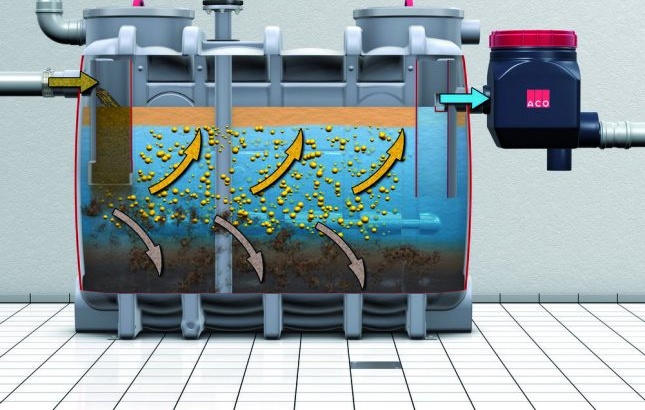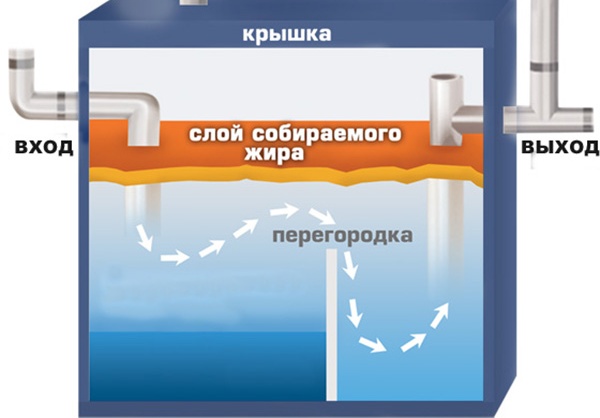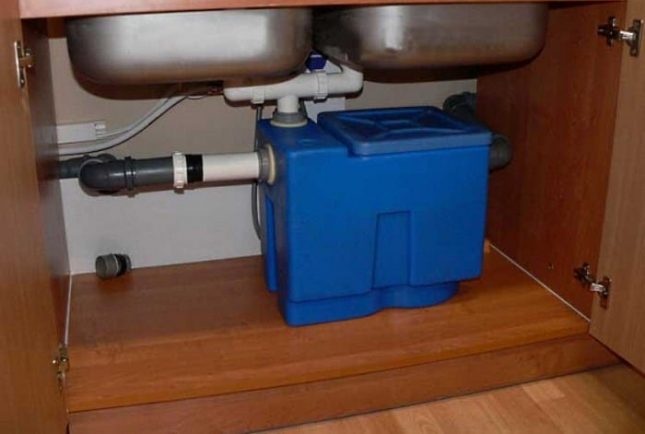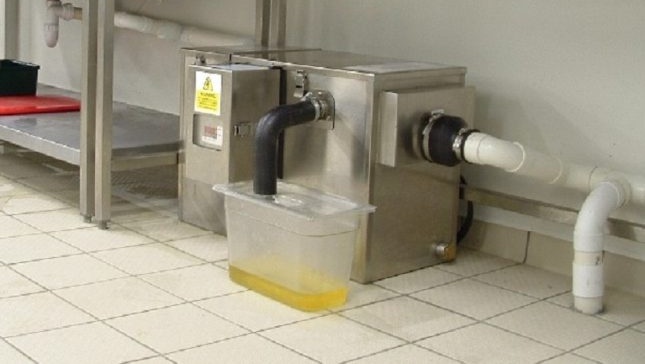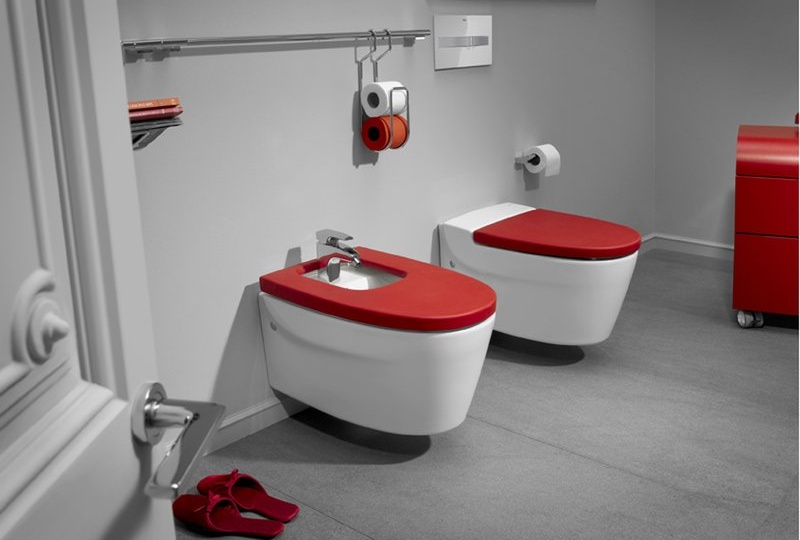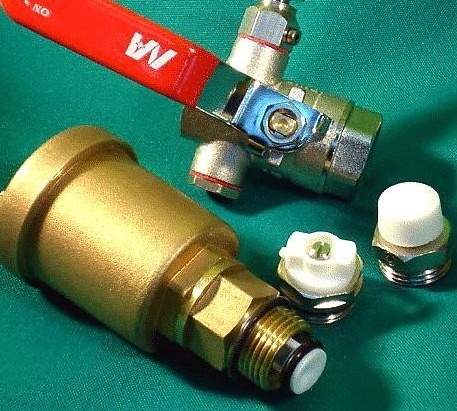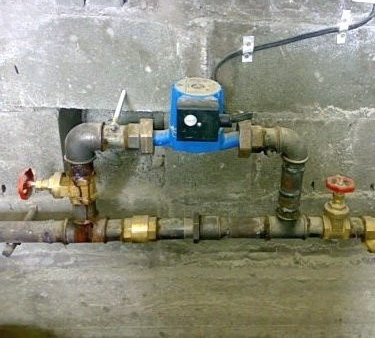What is a grease trap and why is it needed
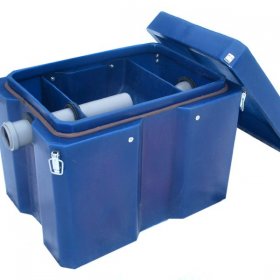
Each zealous owner wants to extend the life of the sewer system, trying to keep the system in order. The most serious nuisance of wastewater disposal is considered blockage. It occurs due to improper slope of pipes, a large amount of solid particles, oils or fats. In Europe, the problem with fats has been solved for a long time and successfully with the help of a grease catcher, in our country this useful device is not so common, let us consider in detail its structure and principle of operation.
Appointment of the device and its types
So that the fats do not get into the drain pipes and do not freeze there in the form of a hard coating, it is advised to install a grease catcher under the sink or other drain point of the plumbing. This device passes water through itself, and the fat remains inside. As accumulation of fat is removed, and the device filters further.
For large food enterprises, industrial grease traps are used in huge volumes, and for small shops and bakeries small household appliances have been developed that are suitable for private houses and apartments.
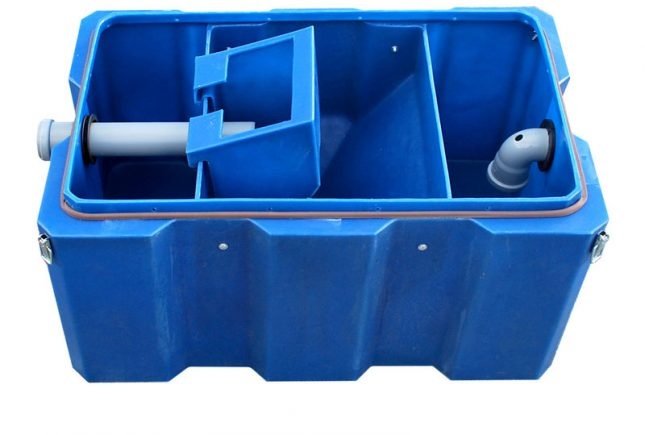
The house must have a means for cleaning the sewer, but if you have to use it constantly, it’s easier to prevent blockages
Models, depending on the application, are made of different materials:
- inexpensive household containers are made of plastic;
- large tanks for installation in basements and wells with plus temperature are made of fiberglass;
- industrial boxes for restaurants and workshops are made of stainless steel or concrete, equipped with additional pumps, level sensors and filters, several partitions, as well as external control panels and automatic cleaning. The performance of such structures reaches 100 liters per second.
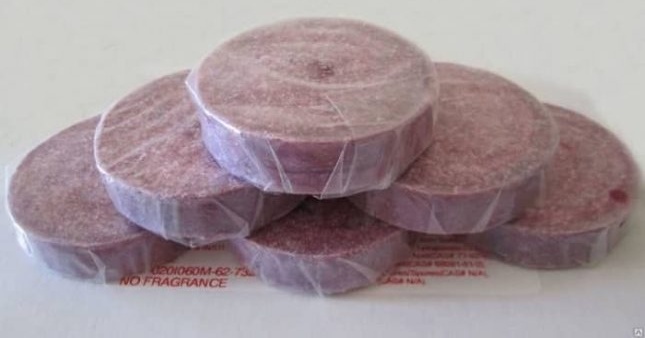
The principle of action of the tablets is based on the decomposition of pollutants due to the complex of anaerobic microbial communities
Modern home models can also have several partitions for better water purification, delayed solid fractions, compartments for the chemical decomposition of fats by drugs or the biological processing of oils by live bacteria. As a result of a process that is absolutely safe for human health, water is obtained with a low sediment content and without an unpleasant odor. This grease trap design can be cleaned much less frequently than a mechanical one.
Where is used
The principle of operation of the grease trap is based on the difference in the density of fat and water. Fat is lighter and always floats on the surface of the water. Liquid comes from a drain into a plastic container, solid particles settle to the bottom, and fats float and accumulate from above. The partition divides the container into two parts and has a gap below.Water from below flows into the second part of the tank, and the fat remains from above, floating in the first half or flowing into a special grease collection tray. At the exit to the sewer pipe, purified water is obtained, which flows freely through the pipes and does not clog them.
Manufacturers produce special grease catchers for installation at key points:
- in the hood;
- under the sink;
- a dishwasher;
- sewer.
Devices are divided according to two main methods of draining waste water:
- volley discharge, in which a complete wash of water is collected, the drain hole is closed with a stopper, and after washing the dishes, all the liquid drains quickly;
- uniform discharge when water flows from the faucet in a stream, so they usually wash dishes at home.
The design of the grease trap is simple, the price is quite affordable, installation is possible with your own hands, the factory kit includes all the necessary seals.
Manufacturers declare the service life of the device at least 30 years with regular cleaning.
Under the sink
When installing the grease trap under the sink, it is often hidden in a cupboard or a lower cabinet, you must immediately leave 3-5 cm on each side of the container. Then, when cleaning and inspecting, the access to the device will be open. Even small plastic models require a solid base, the total weight with water reaches 30–40 kg, and slight vibration and body movement are possible. The drain hose is connected hermetically to the inlet pipe of the device, and the drain pipe is connected to the sewer using gaskets and sealant. Then you need to check the system for leak, if everything is in order, then install the cover. The grease trap is ready to go.
Looking after him is simple:
- Remove the lid and remove from the top a layer of accumulated fat with a shallow wide container or spatula. A small plastic disposable container is fine.
- Remove solids and sediment from the bottom and from the nozzles.
- Rinse with hot water and detergent, replace the cover.
Qualitative and rapid separation of fat from water occurs at a temperature of 5 to 40 ºС.
For sewage
Another installation option involves collecting wastewater from several sinks into a common pipe and connecting to the grease trap, and then to the sewage system. In this case, devices of a larger volume and productivity, about 15 liters per second, are used. Do not hide such dimensions under the sink, they are installed in a separate room or in the basement. During filtration, additional waste breakdown can be used with the help of chemicals produced in the form of tablets. This method gives a high degree of purification, up to 98%, but when decomposing organics, an unpleasant odor may appear that remains outside the residential part of the house.
For external installation in a basement or other separate room, it is important to observe the positive temperature regime, freezing the system can lead to an accident.
For hood
Vapors rising from the hob and gas stove contain a significant amount of fat and soot, which, settling in the air ducts along with dust and cobwebs, contribute to the gradual overgrowing of the pipe. To capture and delay these particles, special filtering devices are built into the hood. As they become dirty, filters can be removed and washed with hot water with a conventional dishwashing detergent.
This simple, environmentally friendly and useful device is able to increase the service life of sewers by several times and save the owners from the troubles associated with blockages in the drain and exhaust pipes. Russian manufacturers produce a wide range of fat separators for domestic and industrial use, the quality of the devices is not inferior to world brands and affordable.
